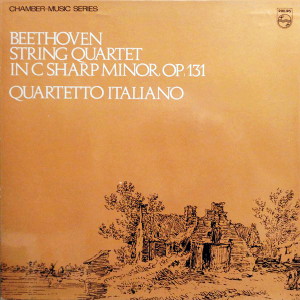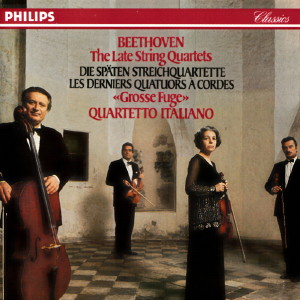 |
|
Philips
- 1 LP - 802 915 - (p) 1969
|
 |
| Philips
- 4 CDs - 426 050-2 - (c) 1989 |
|
| Ludwig van
Beethoven (1770-1827) |
|
|
|
|
|
|
|
| String
Quartet No. 14 in C sharp minor,
Op. 131 |
|
42'
30" |
|
| -
Adagio ma non troppo e molto
espressivo |
8'
51" |
|
|
| -
Allegro molto vivace |
3'
06" |
|
|
| -
Allegro moderato |
0'
58" |
|
|
-
Andante, ma non troppo e molto
cantabile - Più mosso - Andante
moderato e lusinghiero - Adagio -
Allegretto - Adagio ma non troppo e
semplice - Allegretto
|
14'
39" |
|
|
| -
Presto |
5'
37" |
|
|
| -
Adagio, quasi un poco andante |
2'
26" |
|
|
| -
Allegro |
6'
52" |
|
|
|
|
|
|
QUARTETTO
ITALIANO
- Paolo Borciani, Elisa Pegreffi, violino
- Piero Farulli,
viola
- Franco Rossi, violoncello
|
|
|
|
|
|
Luogo e data
di registrazione |
|
Théâtre
Vevey, Vevey (Svizzera)
- 26
luglio / 3 agosto
1969 |
|
|
Registrazione: live
/ studio |
|
studio |
|
|
Producer / Engineer |
|
Vittorio
Negri | Ko
Witteveen |
|
|
Prima Edizione LP |
|
Philips | 802
915
| 1
LP | (p) 1969
|
|
|
Prima Edizione CD |
|
Philips | 426 050-2
| 4
CDs - 63' 45" - 62' 00" - 42'
22" - 47' 10" - (3*,
1-7) | (c)
1989 | ADD
|
|
|
Note |
|
-
|
|
|
|
|
The C sharp
minor quartet, Op. 131,
written in the first half of
1826, the year before the
composer's death, is
Beethoven's penultimate
string quartet and arguably
the greatest of the five
last quartets which
preoccupied him till his
death. It is, in fact, the
natural culmination of the
musical ideas on which he
had based his two previous
quartets, Op. 132 and op.
130 (With its original
finale, the "Grosse Fuge"
now known as op. 133).
The three
quartets together (in
order of composition - Op.
132, Op. 130, and Op. 131)
might be regarded as a
tryptych for everything
points to their artistic
unity. They share a close
thematic relationship
through Beethoven's
obsession at that time
with the four upper notes
of the harmonic minor
scale and he employs these
in almost serial
arrangements throughout
the three works.
Rearranged round the
interval of a rising sixth
they form the opening
notes and thematic germ
cell of Op. 132 and they
ultimately recur in the
same sequence in the
finale of Op. 131. In a
similar arrangement they
form the motto theme of
Op. 130's original finale,
the "Grosse Fuge", and it
is no surprise to find
them again, rearranged
round a third this time,
as the opening notes of
Op. 131. In the finale we
find the four notes
descending in the scale
sequence which originally
fascinated Beethoven
because of the wide
interval of a tone and a
half between the two
middle notes.
Beethoven's
sketchbooks prove that
these remarkable
features cannot be
passed over as
coincidences. Even if
they were there would be
other coincidences to
explain - for instance
the "ABC" sequence of
the tonalities of the
three quartets (A minor,
B flat major, C sharp
minor) and the fact that
they have successively
five, six, and seven
movements. The case for
op. 131 being regarded
as a six-movement work
is admittedly arguable
for the third "movement"
is only ten bars long.
It bears the same A
major key signature as
the movement which
follows and some
critics, notably Vincent
d'Indy, regard it as
simply an introduction.
The tonality, however,
is clearly B minor and
if we take the tonal
centres of the first
four movements - C
sharp, D, B, and A - we
have the same pattern as
the mottos of Op. 132
and the "Grosse Fuge";
the key notes of the
remaining movements
complete a cyclic
progression back to
C sharp for the
finale.
Earlier
in the century, when
the late Beethoven
quartets were
regarded with undue
reverence as the
last words of a
musical superman,
these structural
subtletics were
invested with
metaphysical and
spiritual
significance.
The
detailed analysis
which follow
treats therm
simply as musical
facts and
Beethoven's own
attitude to his
late quartets, in
public at least,
suggest that he
regarded them the
same way. For
instance, before
handing over Op.
131 to the
publisher's agent
on august 12, 1826
he scribbled on
the copy "Put
together from
pilferings from
one thing and
another".
("Zusammengestohlen
aus Verschiedenem
diesem und
jenem".) This
typical
Beethovenian
joke, presumably
based on Op.
131's references
to the other
quartets, so
alarmed Schott
the publisher,
that the
composer had to
write an earnest
letter assuring
him of
the work's
originality.
First
movement:
Beethoven
discards
first-movement
form and
begins with a
fugue which
has a curious
air of
deyacjment.
The opening of
the subject is
derived from a
simple
rearrangement
of the molto
notes of Op.
132 and the
"Grosse Fuge".
The second
part of the
subject soon
becomes
detached and
with its
inversion
forms
contrapuntal
sequences
which carry us
through a
bewildering
maze of keys
(at on stage
we find the
sequence
anticipating
the theme of
Op. 135's
finale) until
the full
subject enters
again in A
major.
We
arrive back in
the home key
with the
tailpiece
again and the
full theme
makes its
final entries
against a
diminution of
it. The
movement
reaches its
climax with
the subject
entering in
augmented form
on the cello
and ends with
pulsing
sforzandi
fading against
the tailpiece
in contrary
motion in the
inner parts.
The tonic C
sharp is heldo
to become the
leading-note
of the next
movement in D
major. (All
the movements,
in fact, are
linked.)
Second
movement:
Again
Beethoven look
back in form,
this time to
the Baroque
suite. The
subject is a
dance-like
theme of only
superficial
cheerfulness.
It makes four
appearances in
all and the
first violin
and viola
share the
first
statement. Two
variants (the
first
transformed
into the
"Grosse Fuge"
motto) carry
us in an
episodic
passage to the
first of three
reappearances
of the theme -
this time in E
major. Then
comes a second
episode
featuring
three
derivative
figures and
forceful piano/forte
contrasts. The
theme
reappears in
the tonic and
Beethoven
proceed with
the first
episode's
"Grosse Fuge"
variant
followed by
the whole
second episode
centred this
time in G
major. In this
key the theme
begins again
on the cello
before the
First violin
takes it over
in the tonic.
The second
part of the
first episode
then provides
the coda.
Third
movement:
Only
ten bars long,
this dramatic
"recitative"
employs a
fragment in
the rhythm of
the next
movement's
theme. Despite
the A major
key signature,
the key centre
is B minor and
within the ten
bars we find a
microcosmic
development in
which the
fragment is
steadily
transformed
until, in a
sudden Adagio,
the universal
motto emerges
first in
retrograde on
the viola and
then shared in
harmony
between first
and second
violins. After
a cadenza-like
flourish on
the first
violin we move
towards A
major for the
next movement.
Fourth
movement:
Here
we have a
restful
theme with
seven
variations.
The first
embellishes
the theme. In
the second, a
più mosso,
Beethoven
fashions a new
melodic tune
against a
variant of the
throbbing
accompaniment.
This builds to
a climax in a
contrapuntal
"roller-coaster"
before the
cello sftly
introduces the
fugato
treatment of
No. 3
based on
fragments of
the theme in
altered
rhythm; next
is an Adagio
on the theme's
harmonic basis
of No. 6 which
wanders into a
recollection
of the
introductory
movement's
"cadenza" and
carries us to
G major. The
theme takes
shape again in
this key in a
little accelerando
before
continuing to
a trilling
accompaniment
on the first
violin. The accelerando
returns in F
major before
the movement
ends with a
coda in the
tonic based on
the
introductory
third
movement.
Fifth
movement:
A
grand scherzo
follows full
of vigorous
humour with a
tinge of
mystery. Its
layout is best
summarised in
the formula
ABABA/CDE/ABA/CDE/ABABA/
Coda and
throughout
there are
reminiscences
of the
variation
movement. The
main scherzo
theme (A), for
instance,
seems to have
roots in the
repetitive
staccato and
cello
interjections
of No. 6. In
the "trio"
section,
passage D is
in A major and
passage E
leads back to
both the tonic
and the
scherzo theme
with an
engaging
pizzicato. The
pattern is
roughly
similar to the
Seventh
Symphony
scherzo and in
the coda
Beethoven
employs his
favourite
scherzo trick
of resummoning
his trio
material only
to cut it
short. Here he
goes one step
further, and
rounds off
with an
impudent
caricature of
the scherzo
played sul
ponticello
(i.e. with the
bow close to
the bridge).
Sixth
movement:
Three
dramatic notes
take us to G
sharp minor
for a very
brief, but
deeply felt adagio
interlude, the
theme of which
is in two
sections. The
second, with
its basic
falling phrase
passing from
instrument to
instrument, is
strikingly
similar to the
second subject
of Op. 132's
first
movement.
Seventh
movement:
The
superb finale
is the logical
conclusion not
only of Op.
131 but also
of its two
predecessors.
It form is
best regarded
as irregular
sonata form. A
powerful
introductory
motif in
unison
precedes the
main theme,
whose rhythm
inevitably
recalls the
opening fugue
of the "Grosse
Fuge." Then
comes a second
theme (in the
tonic) which
opens with the
four
descending
notes that
have been the
basic material
for all three
quartets; the
theme as a
whole has
also the same
rhythmic
pattern as the
first
movement's
fugue subject.
We
then move to E
major for the
third theme
(the true
second
subject), a
simple falling
scale figure
against high
rising third
in the first
violin. The
unison figure
and main theme
then return in
F sharp
minor to begin
the
development.
First comes a
fugato in
which
main-theme
elements are
contrasted
with a subject
based on the
key notes of
the second
theme in
reverse.
Phrases of the
unison figure
against the
third theme's
scales take us
back to the
tonic and a
swelling
oscillation
leads to the
recapitulation
and the
movement's
masterstroke.
Somehow
Beethoven
manages to
combine both
the
preliminary
unison and the
main theme.
And then
suddendly
beneath it all
we hear the
motto of Op.
132 entering
in majestic
fugato. The
recapitulation
then
progresses
fairly
normally
except that
the third
theme recurs
first in D
major before
leading back
to the tonic
for one of
Beethoven's
"terminal
development"
codas. Here
all the
thematic
elements
reappear in a
bewildering
variety of
combinations.
As we near the
final bars the
important
descending
notes of the
second theme
dominate the
scene before
the work ends
with a final
reference to
the decisive
fugato which
began the
recapitulation.
A.
David Hogarth
|
|
|